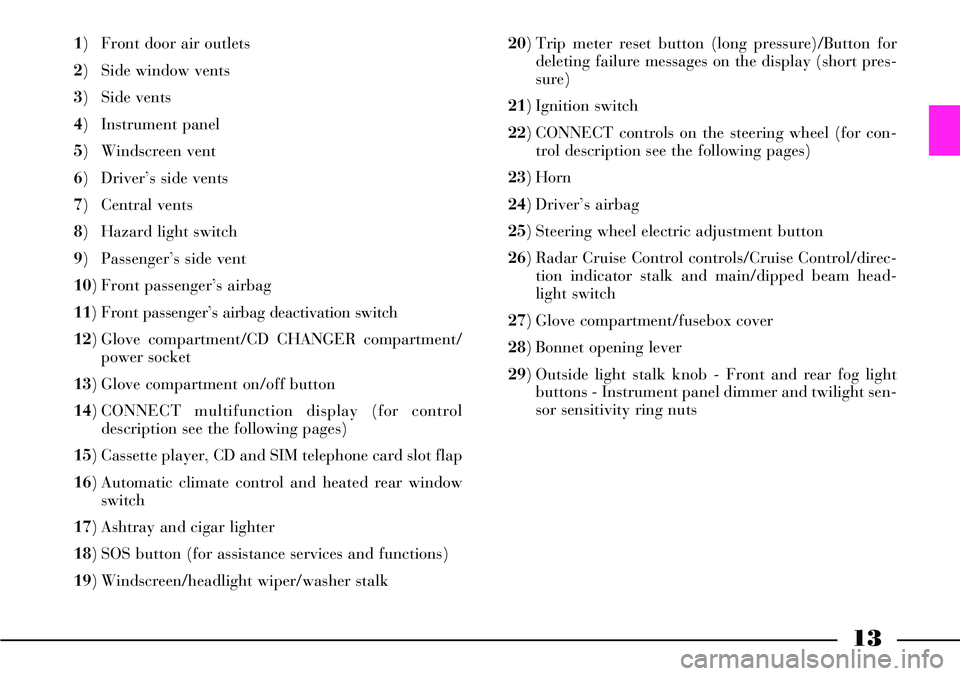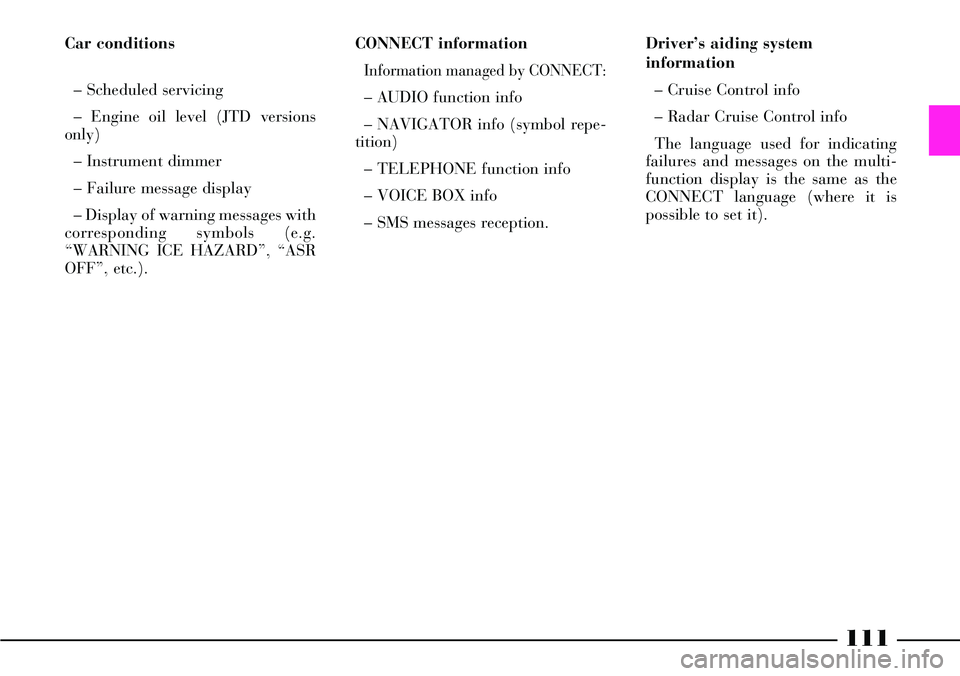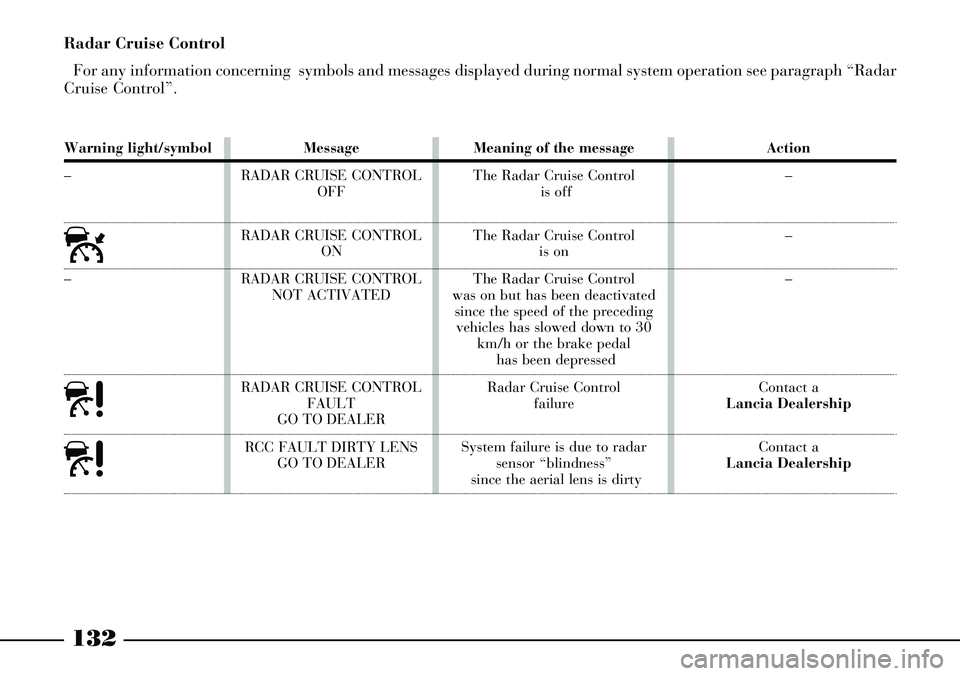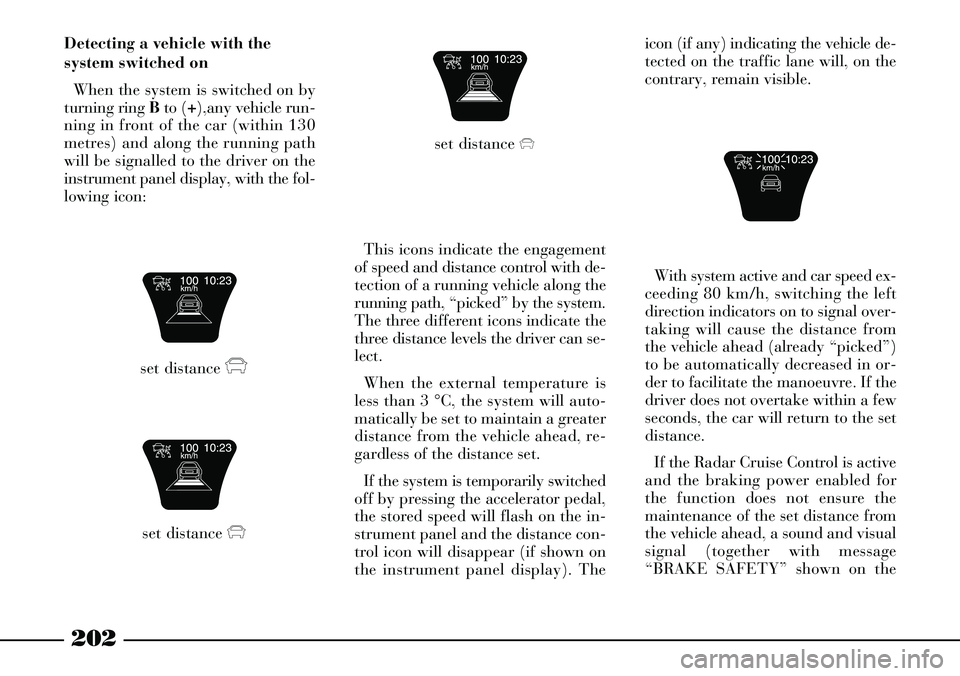cruise control Lancia Thesis 2007 Owner handbook (in English)
[x] Cancel search | Manufacturer: LANCIA, Model Year: 2007, Model line: Thesis, Model: Lancia Thesis 2007Pages: 386, PDF Size: 8.69 MB
Page 14 of 386

13
1) Front door air outlets
2) Side window vents
3) Side vents
4) Instrument panel
5) Windscreen vent
6) Driver’s side vents
7) Central vents
8) Hazard light switch
9) Passenger’s side vent
10) Front passenger’s airbag
11) Front passenger’s airbag deactivation switch
12) Glove compartment/CD CHANGER compartment/
power socket
13) Glove compartment on/off button
14) CONNECT multifunction display (for control
description see the following pages)
15) Cassette player, CD and SIM telephone card slot flap
16) Automatic climate control and heated rear window
switch
17) Ashtray and cigar lighter
18) SOS button (for assistance services and functions)
19) Windscreen/headlight wiper/washer stalk 20) Trip meter reset button (long pressure)/Button for
deleting failure messages on the display (short pres-
sure)
21) Ignition switch
22) CONNECT controls on the steering wheel (for con-
trol description see the following pages)
23) Horn
24) Driver’s airbag
25) Steering wheel electric adjustment button
26) Radar Cruise Control controls/Cruise Control/direc-
tion indicator stalk and main/dipped beam head-
light switch
27) Glove compartment/fusebox cover
28) Bonnet opening lever
29) Outside light stalk knob - Front and rear fog light
buttons - Instrument panel dimmer and twilight sen-
sor sensitivity ring nuts
Page 112 of 386

111
Driver’s aiding system
information
– Cruise Control info
– Radar Cruise Control info
The language used for indicating
failures and messages on the multi-
function display is the same as the
CONNECT language (where it is
possible to set it). Car conditions
– Scheduled servicing
– Engine oil level (JTD versions
only)
– Instrument dimmer
– Failure message display
– Display of warning messages with
corresponding symbols (e.g.
“WARNING ICE HAZARD”, “ASR
OFF”, etc.).CONNECT information
Information managed by CONNECT:
– AUDIO function info
– NAVIGATOR info (symbol repe-
tition)
– TELEPHONE function info
– VOICE BOX info
– SMS messages reception.
Page 132 of 386

131
Car speed
Warning light/symbol
4
Message
SPEED LIMIT
EXCEEDED
SLOW DOWNMeaning of the message
Car speed is exceeding
the limit set on the CONNECTAction
Reduce car speed
Cruise Control
Warning light/symbol
Ü
Message
CRUISE CONTROL
ONMeaning of the message
The Cruise Control (constant
speed adjusting device) is activatedRemarks
-
Page 133 of 386

132
Warning light/symbol
–
ú
–
à
à
Message
RADAR CRUISE CONTROL
OFF
RADAR CRUISE CONTROL
ON
RADAR CRUISE CONTROL
NOT ACTIVATED
RADAR CRUISE CONTROL
FAULT
GO TO DEALER
RCC FAULT DIRTY LENS
GO TO DEALERMeaning of the message
The Radar Cruise Control
is off
The Radar Cruise Control
is on
The Radar Cruise Control
was on but has been deactivated
since the speed of the preceding
vehicles has slowed down to 30
km/h or the brake pedal
has been depressed
Radar Cruise Control
failure
System failure is due to radar
sensor “blindness”
since the aerial lens is dirtyAction
–
–
–
Contact a
Lancia Dealership
Contact a
Lancia Dealership
Radar Cruise Control
For any information concerning symbols and messages displayed during normal system operation see paragraph “Radar
Cruise Control”.
Page 195 of 386

194
CRUISE CONTROL
(CONSTANT SPEED
REGULATOR)
GENERAL
The electronic cruise control allows
to drive your car at the required
speed without pressing the accelera-
tor pedal. This reduces fatigue when
driving on motorways, especially
during long journeys, because the
set speed is automatically main-
tained.
IMPORTANTThe device can only
be set to speeds exceeding 30 km/h
(40 to 180 km/h for 2.4 JTD 20V
CAE version).The cruise control must
only be used when the
road and traffic condi-
tions allow to keep a constant
speed in total safety for an ade-
quately long time.CONTROLS (fig. 143)
The cruise control is operated by
means of switch A, ring Band but-
ton C(RCL).
Switch Ahas two positions:
– OFFin this position, the device is
off
– ONthis is the normal device
operating position. When the device
is ON, symbol Ülights up on the
multifunction display, together with
message “CRUISE CONTROL ON”.
Ring Bis used to set and maintain
the car speed or to increase or
decrease the set speed.
The device is automatically
switched off when:
– the brake pedal is pressed
– the clutch pedal is pressed
– the gear lever is unintentionally
shifted to N.
In versions with auto-
matic transmission, never
shift the lever to N when
the car is running.
fig. 143
L0A0208b
Page 197 of 386

196
or
– by momentarily turning ring Bto
(+): each turn of the ring will corre-
spond to a small speed increase
(approximately 1 km/h), while a
continuous pressure will correspond
to a continuous speed increase.
Release ring B: the new speed will
automatically be stored.
Reducing the stored speed
The stored speed can be decreased
in two ways:
– by switching the device off (e.g.
by pressing the brake pedal) and
then storing the new speed (turning
ring Bto (+) for longer than three
seconds)
or
– by turning ring Bto (–) until the
new speed is reached. The new speed
will automatically be stored.Deleting the stored speed
The stored speed is automatically
deleted when:
– the engine is stopped
or
– switch Ais turned to OFF.
When driving with the
cruise control, do not
shift the gear lever to neu-
tral. You should only switch the
cruise control on when the traffic
and road conditions allow this in
complete safety, i.e. straight and
dry roads, motorways, fast mov-
ing traffic and smooth road sur-
face. Do not use the device in
cities or in heavy traffic.The cruise control can
be switched on at speeds
higher than 30 km/h (40
to 180 km/h for 2.4 JTD 20V CAE
version). The device can only be
switched on in 4th, 5th or 6th
gear, according to car speed. In
versions with automatic trans-
mission, the device must only be
switched on with the gear lever at
D during automatic operation
without shifting the lever subse-
quently, or with the 3
rdor 4thgear
engaged during manual sequen-
tial operation.
When travelling down-hill the
speed may increase with respect
to the stored value according to
the change in engine load.
Page 198 of 386

197
RADAR CRUISE
CONTROL (RCC)
GENERAL
The Radar Cruise Control (RCC)
assists the driver by monitoring both
the cruise speed and the distance of
the vehicle ahead along the running
path: it allows to drive your car at
the required speed, without pressing
the accelerator pedal.
The system reduces fatigue when
driving on motorways, especially
during long journeys, since the
stored speed is maintained automat-
ically; moreover, the system con-
tributes to keeping a safe distance
from the vehicle ahead. Constant
speed driving also allows to cut
down fuel consumption and makes
traffic smoother.The Radar Cruise
Control is not an “auto-
matic pilot” but a driver-
assisting device; therefore, only
the driver is responsible for
his/her driving behaviour and
must comply with the highway
code regulations in force, as well
as with any other provision con-
cerning road traffic.
This system detects just
moving vehicles and
ignores whatever immo-
bile object.The Radar Cruise
Control is not an anti-col-
lision device: it cannot
detect the presence of obstacles
on the road or stop the car in case
of danger. Any action performed
by the driver on the brake or
accelerator pedals takes priority
over the cruise control system; for
this reason, the responsibility for
road safety always rests with the
driver.
The system is electronically con-
trolled, self-contained and, there-
fore, does not require communica-
tion with other vehicles or the pres-
ence of similar systems on the other
vehicles.
The system cannot actu-
ate emergency braking:
the maximum decelera-
tion automatically performed by
the system is limited compared to
the actual braking power of the
brake system; therefore, emer-
gency braking can and must be
performed only by the driver.
Page 199 of 386

198
The Radar Cruise Control
must only be used when
the road and traffic condi-
tions allow to keep a constant
speed in total safety for an ade-
quately long time. IMPORTANTThe system can only
be switched on when the car speed
ranges from 30 to 160 km/h and is
automatically switched off by press-
ing the brake pedal. If the car speed
falls below 30 km/h when the system
is on, a buzzer and a visual indication
warn the driver to take control of car
speed again. When the car speed ex-
ceeds 160 km/h after a slight acceler-
ation (“override” mode), a buzzer and
a visual indication will warn the dri-
ver that the system is off.
IMPORTANTThe Radar Cruise
Control cannot be activated when the
driver has switched the ASR system
off.CONTROLS (fig. 144)
The Radar Cruise Control is oper-
ated by three controls, as well as by
the accelerator (to increase speed)
and the brake pedal (to switch the
system off).
Controls are as follows:
– ring Ato switch the system on/off
and to set the distance from the
vehicle ahead, depending on its
speed
– ring B to increase/decrease the
set speed
– button Cto restore the stored
speed.
fig. 144
L0A0020b
As long as the car speed exceeds
160 km/h, one of the following indi-
cations will warn the driver that themax. speed limit controlled by the
system is exceeded.
If the road in front of car fitted
with Radar Cruise Control is free.
If a vehicle is detected in front of
the car fitted with Radar Cruise
Control.
Page 200 of 386

199
Ring Ahas four positions:
OFF: system off
x: greatest distance from the vehi-
cle ahead
x: intermediate distance from the
vehicle ahead
x: shortest distance from the vehi-
cle ahead.
The distance between the two vehi-
cles is gradually increased as the
speed is increased, set levels being
equal.
IMPORTANTTurn the ignition
key to STOPor ring Ato OFF, to
delete the stored speed and switch
the system off. To restore system
operation, turn the ring Ato OFF
and repeat the setting operations.When the system is on, that is, ring
Ais in any position other than OFF,
symbol úlights up on the multi-
function display, together with mes-
sage “RADAR CRUISE CONTROL
ON”. The warning light will remain
on until the system is switched off by
turning ring Ato OFF.
Ring Bis used to store the car
speed and keep it constant, or to
increase or decrease the stored
speed.
Turn ring Bto (+) to store the
speed reached or increase the stored
speed.
Turn ring Bto (–) to decrease the
stored speed. Slowing down can also
be obtained, when required, by
braking system automatic operation.
Every time ring Bis turned, the
speed is increased or decreased by
about 1 km/h. By keeping the ring
rotated, the stored speed will change
continuously at intervals of 10
km/h. The new speed reached will
be maintained automatically.
When ring Bis turned, the car’s
actual speed is considered as refer-
ence speed (cruise speed). This
speed can automatically decrease
depending on traffic conditions, and
the system can shift from the speed
control condition to the distance
control condition. The driver is
informed of the system’s operating
condition by the instrument panel
display.
Button C(RCL) allows to reset the
stored speed. In fact, when driving
the car with the system on, the dri-
ver can switch the system off by sim-
ply braking. In this case, the cruise
speed previously set is kept in the
memory and can be enabled again at
any time by pressing button RCL.
Page 203 of 386

202
Detecting a vehicle with the
system switched on
When the system is switched on by
turning ring Bto (+),any vehicle run-
ning in front of the car (within 130
metres) and along the running path
will be signalled to the driver on the
instrument panel display, with the fol-
lowing icon:
set distancex
set distancexset distance
x
This icons indicate the engagement
of speed and distance control with de-
tection of a running vehicle along the
running path, “picked” by the system.
The three different icons indicate the
three distance levels the driver can se-
lect.
When the external temperature is
less than 3 °C, the system will auto-
matically be set to maintain a greater
distance from the vehicle ahead, re-
gardless of the distance set.
If the system is temporarily switched
off by pressing the accelerator pedal,
the stored speed will flash on the in-
strument panel and the distance con-
trol icon will disappear (if shown on
the instrument panel display). Theicon (if any) indicating the vehicle de-
tected on the traffic lane will, on the
contrary, remain visible.
With system active and car speed ex-
ceeding 80 km/h, switching the left
direction indicators on to signal over-
taking will cause the distance from
the vehicle ahead (already “picked”)
to be automatically decreased in or-
der to facilitate the manoeuvre. If the
driver does not overtake within a few
seconds, the car will return to the set
distance.
If the Radar Cruise Control is active
and the braking power enabled for
the function does not ensure the
maintenance of the set distance from
the vehicle ahead, a sound and visual
signal (together with message
“BRAKE SAFETY” shown on the